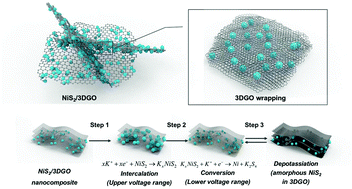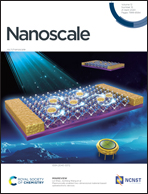Three-dimensional graphene-supported nickel disulfide nanoparticles promise stable and fast potassium storage†
Abstract
Nickel sulfide (NiS2) is generally regarded as an appropriate anode for manufacturing new-type potassium-ion batteries (PIBs), while the development and application of NiS2 are hampered by poor intrinsic electrical conductivity and huge volumetric change during potassiation/de-potassiation. Herein, we construct self-adaptive NiS2 nanoparticles confined to a three-dimensional graphene oxide (NiS2/3DGO) electrode via in situ sulfurization and self-assembly processes. The as-obtained NiS2/3DGO exhibits high reversible capacity (391 mA h g−1) and outstanding rate behavior (stable cycling at 1000 mA g−1) for PIBs. Furthermore, in situ X-ray diffractometry and ex situ Raman test results elucidate partially reversible transformation from the cubic NiS2 phase to the KxNiS2 intermediate, followed by generating a Ni0 and K2S4 product. This phenomenon is caused by the conversion reaction mechanism of NiS2 nanocrystals along with an amorphous phase transition during the initial cycle. Such understandings may shed new light on the application of metal sulfides and give directions to design novel electrodes with desirable structural stability and lifespan.

- This article is part of the themed collections: Advanced Nanomaterials for Energy Conversion and Storage and 2020 Nanoscale HOT Article Collection


 Please wait while we load your content...
Please wait while we load your content...